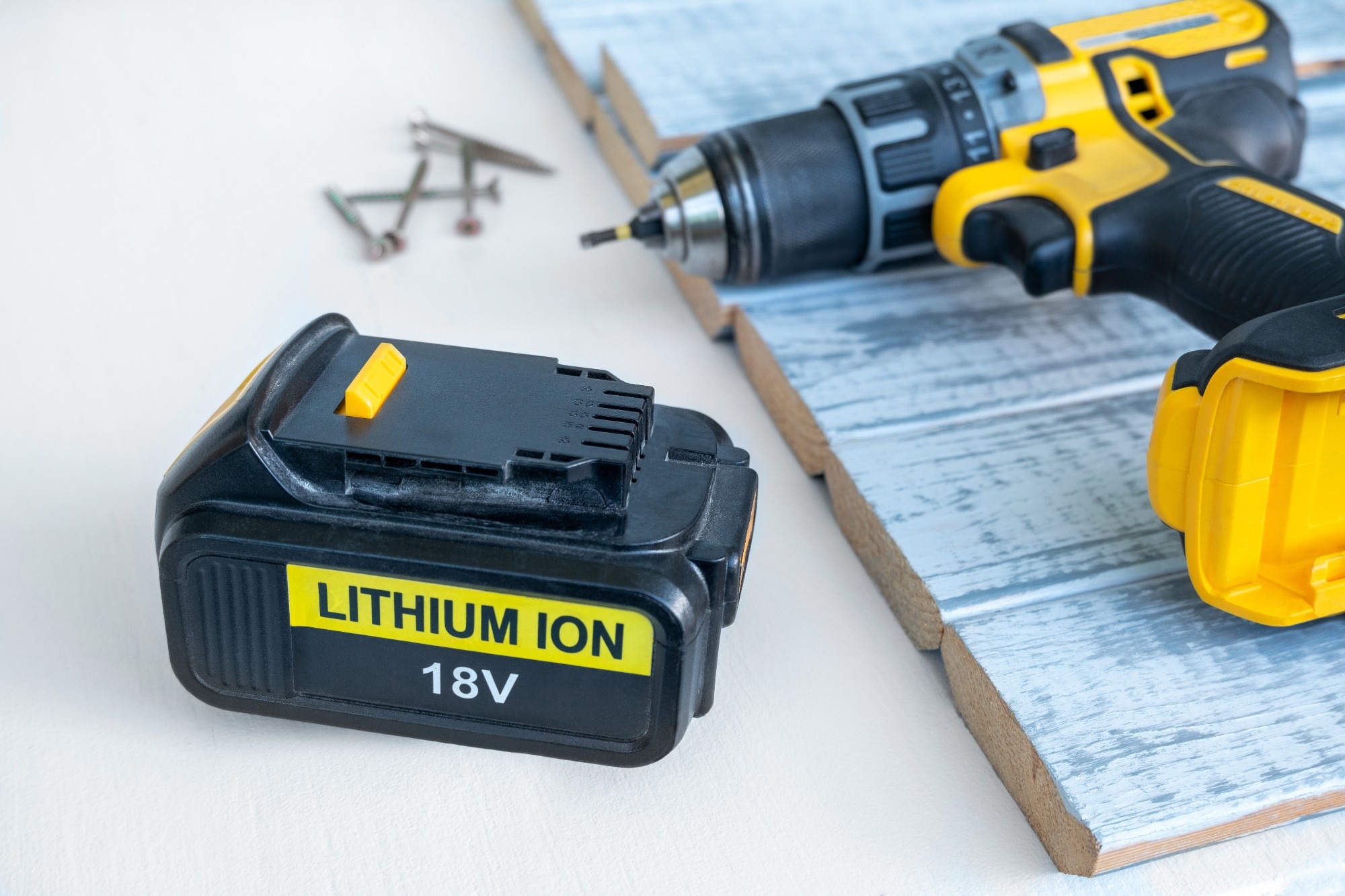 By Ankit SinghReviewed by Susha Cheriyedath, M.Sc.Dec 10 2024
By Ankit SinghReviewed by Susha Cheriyedath, M.Sc.Dec 10 2024The electrification of construction machinery has been underway for some time, aiming to significantly reduce greenhouse gas emissions and meet the ambitious targets outlined in the Paris Agreement.

Image Credit: Nina Unruh/Shutterstock.com
By powering construction equipment with efficient, long-lasting batteries, the industry reduces reliance on fossil fuels, minimizes noise pollution, and achieves greater operational flexibility. Here’s how battery technology is reshaping construction and driving innovation worldwide.
The Rise of Battery-Powered Construction
The integration of battery-powered equipment in construction offers significant advantages. Traditional diesel-powered machinery, while reliable, emits greenhouse gases and generates substantial noise. Battery-powered alternatives provide quieter operations, making them ideal for urban construction projects where noise restrictions apply during nighttime hours. Additionally, the adoption of renewable energy to recharge these batteries further enhances their sustainability.1,2
Electric equipment also requires less maintenance due to fewer moving parts, lowering operational costs and increasing efficiency. These benefits make battery technology not only environmentally responsible but also economically viable.1,2
Sustainable Infrastructure Powered by Batteries: Case Studies
Several major infrastructure projects have embraced battery-powered equipment to achieve sustainability goals and ensure uninterrupted work.
London’s HS2 High-Speed Rail Project, United Kingdom
The HS2 high-speed rail project is revolutionizing construction in the UK, emphasizing sustainability. Battery-powered excavators and cranes are being deployed for tunneling and earth-moving tasks in urban areas. These machines significantly reduce noise pollution, which is crucial for working near residential zones, and ensure compliance with stringent emissions standards.
HS2 also employs renewable energy sources for recharging batteries, further minimizing the project’s carbon footprint. This integration of clean technologies supports the UK government’s goal of achieving net-zero emissions by 2050, showcasing how large-scale infrastructure projects can leverage battery technology for both environmental and operational benefits.3
The Line at NEOM, Saudi Arabia
The Line, a revolutionary linear smart city within NEOM, is utilizing battery-powered construction equipment to meet its zero-emissions vision. Fully electric cranes, loaders, and concrete mixers are employed to minimize the ecological impact while maintaining round-the-clock progress. The harsh desert environment demands robust battery solutions, driving innovations in heat-resistant energy storage.
Additionally, solar energy is used to recharge equipment, creating a closed-loop sustainable system. This approach not only aligns with Saudi Arabia’s Vision 2030 goals but also serves as a global model for integrating advanced battery technology into large-scale urban development projects.4
California High-Speed Rail Project, United States
The California High-Speed Rail project is a prime example of incorporating battery-powered equipment to meet strict environmental standards. From electric excavators to battery-powered drills, these machines operate quietly, facilitating night shifts near residential and commercial areas. The project is designed to connect major cities while reducing reliance on fossil fuels in construction and eventual train operations.
A unique aspect is the use of portable battery stations on-site, ensuring continuous operations even in remote areas. This initiative demonstrates how battery technology supports both immediate construction goals and broader sustainability objectives by lowering carbon emissions throughout the project lifecycle.5
Thames Tideway Tunnel, United Kingdom
The Thames Tideway Tunnel, London’s ambitious “super sewer” project, integrates battery-powered construction equipment to operate efficiently around the clock. Electric excavators and cranes reduce noise and air pollution, ensuring compliance with strict environmental regulations in densely populated areas. With sections of the tunnel constructed beneath residential zones, battery-powered machinery minimizes disruption during nighttime operations.
Renewable energy is also used to recharge equipment, aligning with the project’s sustainability objectives. This innovative approach not only accelerates project timelines but also demonstrates the UK’s commitment to cleaner construction methods in addressing critical urban infrastructure challenges.6
Leaders of Battery Tech in Construction
The construction industry is experiencing a significant transformation driven by innovative companies that are leading the way in battery-powered equipment. These pioneers are enhancing efficiency and sustainability on construction sites.
Caterpillar, for example, has introduced a diverse range of battery-electric construction equipment, including excavators and compact loaders. Their lineup features models such as the 301.9 mini excavator, the 320 medium excavator, the 950 GC medium wheel loader, and the 906 compact wheel loader. Caterpillar’s emphasis on modular battery packs provides operators with the flexibility to customize energy requirements for specific tasks, promoting both performance and sustainability throughout the equipment's lifecycle.
Volvo CE is another key player in this shift toward electric machinery. Their electric compact equipment lineup is designed for urban projects, focusing on low emissions and quiet operation. Models like the EWR150 Electric wheeled excavator and the ECR25 Electric compact excavator excel in navigating tight spaces while minimizing noise pollution. Additionally, Volvo CE has introduced the PU40, a mobile power unit with a 40 kWh capacity that can charge various equipment on-site. This commitment to sustainability and efficiency positions Volvo CE as a leader in urban construction solutions.
Komatsu is also making strides in battery technology, emphasizing durability and high energy density in their electric construction equipment. Their offerings include the PC138E-11 all-electric excavator and the PC33E-6 electric mini-excavator. Notably, the PC138E-11 features a robust 225-kWh lithium-ion battery that allows for extended operation hours while ensuring optimal performance under demanding conditions. Komatsu’s focus on efficiency makes their machines well-suited for various terrains.
Hitachi Construction Machinery has also entered the electric equipment market with the ZX55U-E3 battery-powered mini excavator, designed specifically for optimal performance in confined spaces. This innovation reflects Hitachi's dedication to meeting the evolving needs of modern construction sites.
Together, these industry leaders are not only expanding their electric construction equipment portfolios but also driving the transition toward more sustainable practices in construction. Their innovations enhance operational efficiency while significantly reducing emissions, contributing to a greener future for the industry.
The Impact of Battery Technology on Construction
Battery technology is having a huge impact on the construction industry, specificallyby enabling 24/7 operations. One of the key advantages is the ability to work continuously without the noise and emissions associated with traditional diesel-powered machinery. Battery-powered equipment operates quietly, allowing construction teams to extend their working hours into the night or in noise-sensitive areas. This capability accelerates project timelines and boosts overall productivity.
In addition to facilitating round-the-clock operations, battery technology enhances sustainability in construction. By reducing reliance on fossil fuels, electric machinery lowers greenhouse gas emissions, helping companies meet their environmental targets. Battery Energy Storage Systems (BESS) provide a reliable power source that can integrate with renewable energy options, optimizing energy management on job sites.
The shift to battery-powered machinery also improves worker safety and comfort. Electric equipment eliminates harmful diesel fumes and significantly reduces noise levels, creating a healthier work environment. This focus on safety is essential for maintaining productivity while protecting the well-being of construction crews.
Moreover, battery technology offers flexibility for projects in remote locations where access to electricity may be limited. Mobile power units can supply energy for various construction activities, enabling teams to take on ambitious projects regardless of their location.2
Check out this article and learn more about how the construction industry aims for a 30 % CO2 reduction by 2030 from the experts at Malvern Panalytical!
Innovations Overcoming Battery-Powered Construction Challenges
While promising, battery-powered construction equipment faces challenges, including limited battery capacity, long charging times, and high upfront costs. However, manufacturers are working to address these issues with innovative solutions:
- Improving Energy Density: Researchers are developing next-generation batteries, such as solid-state and lithium-sulfur technologies, to enhance energy density and extend operational hours.1,2 For example, Fortescue and Liebherr have jointly developed a 6 MW DC fast charger capable of charging a 1,900 kWh battery in a 230-ton haul truck in less than 30 minutes.
- Fast Charging Technology: Advancements in ultra-fast charging systems are minimizing downtime and increasing productivity. Volvo Construction Equipment and Portable Electric have introduced the PU130, a mobile charging unit that can rapidly recharge equipment over a lunch break.1,2 This means that workers can service a full workday without operational interruptions.
- Cost Reduction: The total cost of ownership for electric construction equipment is becoming more favorable. Battery-electric machines have lower maintenance and operating costs, with no oil changes, engine or transmission rebuilds, and fewer moving parts. As battery prices continue to fall below $400/kWh, the economic viability of electric construction equipment improves.1,2
Collaborative Efforts Driving Battery Integration
The integration of battery technology in construction is further strengthened by collaborations among equipment manufacturers, renewable energy providers, and research institutions. These partnerships are essential for driving the adoption of electric machinery.
A notable example is the collaboration between Volvo and Northvolt. Together, they are working on establishing a new battery manufacturing plant in Gothenburg, Sweden, which aims to produce sustainable batteries with a
potential annual capacity of up to 50 GWh. This partnership not only enhances battery production but also significantly reduces the environmental impact associated with sourcing materials.
Governments are also playing a crucial role in this transition by offering subsidies and grants to support the adoption of electric machinery. In the UK, for instance, the Department for Business Energy and Skills awarded a grant worth £407,112 to Danfoss Power Solutions to accelerate the electrification of construction machinery. This funding will help develop next-generation technologies that promote sustainability.
Additionally, global organizations like the International Energy Agency (IEA) are advocating for policies that standardize the use of battery-powered equipment across the industry. These cooperative efforts ensure that technological advancements are implemented swiftly and effectively.
These cooperative efforts ensure technological advancements are swiftly implemented, creating a unified push toward a cleaner, more efficient construction industry.
Conclusion
The electrification of construction machinery is a significant step toward a more sustainable and efficient industry. By transitioning to battery-powered equipment, construction projects can reduce greenhouse gas emissions, minimize noise pollution, and enhance operational flexibility. This shift not only aligns with global sustainability goals but also offers economic advantages through lower maintenance costs and increased efficiency.
As the industry moves forward, stakeholders must actively engage in this transition. Investing in training for workers, exploring funding opportunities for electric machinery, and advocating for supportive policies are crucial steps. By embracing battery technology now, construction professionals can lead the charge toward a more sustainable future while enhancing operational efficiency and reducing environmental impact.
To read more about construction trends other than electrification, check out our article on the Top 10 Construction Trends to Watch in 2025!
References and Further Reading
- Huang, X. et al. (2024). Prospects for purely electric construction machinery: Mechanical components, control strategies and typical machines. Automation in Construction, 164, 105477. DOI:10.1016/j.autcon.2024.105477. https://www.sciencedirect.com/science/article/abs/pii/S0926580524002139
- Mocera, F., & Somà, A. (2022). Chapter 4: A review of hybrid electric architectures in construction, handling and agriculture machines. New Perspectives on Electric Vehicles, 49. https://www.google.co.in/books/edition/New_Perspectives_on_Electric_Vehicles/jtFuEAAAQBAJ
- The UK’s first fully electric crawler cranes start work on HS2 as the project moves towards diesel free construction sites. (2022). HS2 News and Information. https://mediacentre.hs2.org.uk/news/the-uks-first-fully-electric-crawler-cranes-start-work-on-hs2-as-the-project-moves-towards-diesel-free-construction-sites
- THE LINE: a revolution in urban living. NEOM: Made to Change. https://www.neom.com/en-us/regions/theline
- Sustainability Practices. California High Speed Rail. https://hsr.ca.gov/programs/green-practices-sustainability/
- An electric Hydrofraise® on the Tideway project in London. CORPORATE SB - The world leader in foundations and soil technologies. https://www.soletanche-bachy.com/en/united-kingdom-spotlight-on-the-hydrofraise-in-action-on-the-tideway-project/
Disclaimer: The views expressed here are those of the author expressed in their private capacity and do not necessarily represent the views of AZoM.com Limited T/A AZoNetwork the owner and operator of this website. This disclaimer forms part of the Terms and conditions of use of this website.